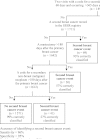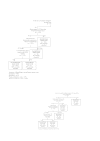Administrative data algorithms to identify second breast cancer events following early-stage invasive breast cancer
- PMID: 22547340
- PMCID: PMC3732250
- DOI: 10.1093/jnci/djs233
Administrative data algorithms to identify second breast cancer events following early-stage invasive breast cancer
Abstract
Background: Studies of breast cancer outcomes rely on the identification of second breast cancer events (recurrences and second breast primary tumors). Cancer registries often do not capture recurrences, and chart abstraction can be infeasible or expensive. An alternative is using administrative health-care data to identify second breast cancer events; however, these algorithms must be validated against a gold standard.
Methods: We developed algorithms using data from 3152 women in an integrated health-care system who were diagnosed with stage I or II breast cancer in 1993-2006. Medical record review served as the gold standard for second breast cancer events. Administrative data used in algorithm development included procedures, diagnoses, prescription fills, and cancer registry records. We randomly divided the cohort into training and testing samples and used a classification and regression tree analysis to build algorithms for classifying women as having or not having a second breast cancer event. We created several algorithms for researchers to use based on the relative importance of sensitivity, specificity, and positive predictive value (PPV) in future studies.
Results: The algorithm with high specificity and PPV had 89% sensitivity (95% confidence interval [CI] = 84% to 92%), 99% specificity (95% CI = 98% to 99%), and 90% PPV (95% CI = 86% to 94%); the high-sensitivity algorithm had 96% sensitivity (95% CI = 93% to 98%), 95% specificity (95% CI = 94% to 96%), and 74% PPV (95% CI = 68% to 78%).
Conclusions: Algorithms based on administrative data can identify second breast cancer events with high sensitivity, specificity, and PPV. The algorithms presented here promote efficient outcomes research, allowing researchers to prioritize sensitivity, specificity, or PPV in identifying second breast cancer events.
Figures






References
-
- National Cancer Institute. Overview of the SEER Program. 2011. http://seer.cancer.gov/about/overview.html. Accessed April 4, 2012.
-
- Chen SL, Martinez SR. The survival impact of the choice of surgical procedure after ipsilateral breast cancer recurrence. Am J Surg. . 2008;196(4):495–499. - PubMed
-
- Hershman D, Neugut AI, Jacobson JS, et al. Acute myeloid leukemia or myelodysplastic syndrome following use of granulocyte colony-stimulating factors during breast cancer adjuvant chemotherapy. J Natl Cancer Inst. . 2007;99(3):196–205. - PubMed
-
- Thompson D, Taylor DC, Montoya EL, Winer EP, Jones SE, Weinstein MC. Cost-effectiveness of switching to exemestane after 2 to 3 years of therapy with tamoxifen in postmenopausal women with early-stage breast cancer. Value Health. . 2007;10(5):367–376. - PubMed
-
- Stokes ME, Thompson D, Montoya EL, Weinstein MC, Winer EP, Earle CC. Ten-year survival and cost following breast cancer recurrence: estimates from SEER-Medicare data. Value Health. . 2008;11(2):213–220. - PubMed
Publication types
MeSH terms
Grants and funding
LinkOut - more resources
Full Text Sources
Medical

